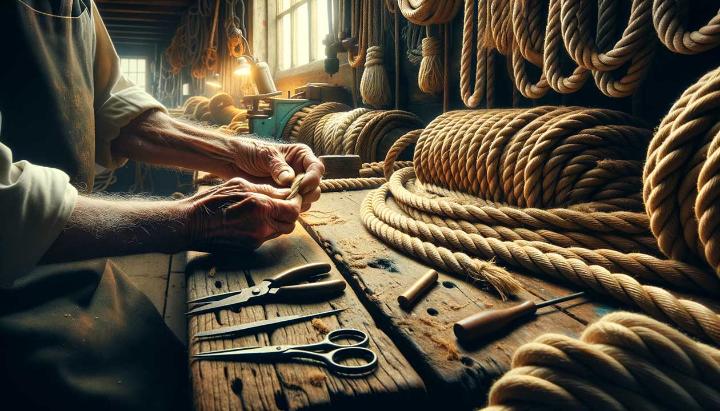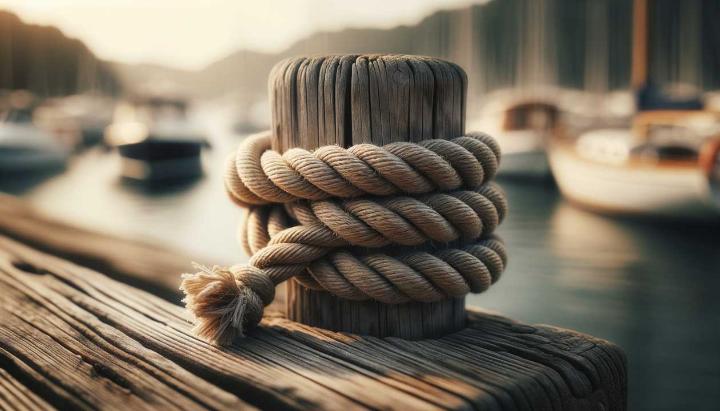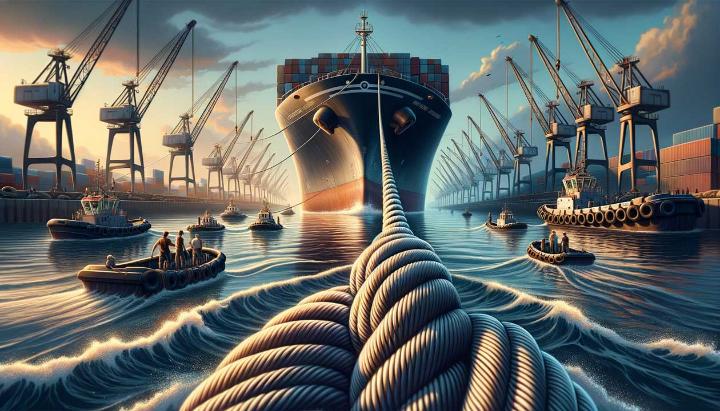Have you ever wondered why seasoned sailors and outdoor enthusiasts swear by 3 strand nylon line? It's not just a matter of tradition; these versatile ropes pack a punch when it comes to strength, durability, and performance. Whether you're anchoring your boat in choppy waters or securing equipment for a rugged off-road adventure, the humble 3 strand line might just be your secret weapon.
At iRopes, we've seen firsthand how the right rope can make all the difference. That's why we're excited to dive into the world of 3 strand nylon line and anchor line, exploring their unique benefits and wide-ranging applications. From marine environments to industrial settings, these ropes have proven their worth time and time again.
In this post, we'll unravel the mysteries of 3 strand line construction, compare it to other rope types, and showcase its versatility across industries. We'll also delve into the specific advantages of 3 strand nylon line, including its impressive strength-to-weight ratio and excellent shock absorption properties. For boating enthusiasts, we'll highlight why 3 strand anchor lines are a game-changer for secure and smooth anchoring.
So, whether you're a wholesale customer looking for high-quality, customised rope solutions or simply curious about the ropes that keep our world running smoothly, buckle up. You're about to discover why 3 strand nylon line and anchor line are the unsung heroes of the rope world.
Understanding 3 Strand Line: Construction and Uses
Have you ever wondered what makes a 3 strand line so special? As a seasoned sailor, I've had my fair share of experiences with various types of ropes, but there's something about the 3 strand line that keeps me coming back. Let's dive into the world of this versatile rope and discover why it's been a staple in marine and industrial applications for generations.
Composition and Characteristics of 3 Strand Rope
At its core, a 3 strand rope is exactly what it sounds like - three individual strands twisted together to form a single, strong line. This simple yet effective construction method has stood the test of time, offering a perfect balance of strength, flexibility, and ease of use.
The beauty of 3 strand rope lies in its versatility. Depending on your needs, you can find it made from various materials, including:
- Nylon: Known for its excellent strength and stretch properties, perfect for mooring lines and anchor rodes.
- Polyester: Offers great UV resistance and minimal stretch, ideal for halyards and sheets.
- Polypropylene: Lightweight and floats on water, making it suitable for water sports and rescue lines.
- Manila: A natural fibre rope with a classic look and feel, often used for decorative purposes or traditional rigging.
Each material brings its own unique characteristics to the table, allowing you to choose the perfect 3 strand rope for your specific application.
Splicing Techniques for 3 Strand Line
One of the standout features of 3 strand rope is its ease of splicing. As someone who's spent countless hours working with ropes, I can attest to the satisfaction of creating a perfect eye splice or joining two ropes seamlessly.

Here's a quick guide to creating a basic eye splice:
- Unlay the strands at the end of your rope for about 12 inches.
- Form a loop of the desired size, and weave each strand back into the main body of the rope.
- Continue weaving for at least five tucks, tapering the strands as you go.
- Trim any excess and whip the end for a clean finish.
With a bit of practice, you'll be creating professional-looking splices in no time. It's a skill that not only enhances the functionality of your rope but also connects you to a long tradition of seamanship and craftsmanship.
Applications and Advantages of 3 Strand Rope
The versatility of 3 strand rope makes it a go-to choice for a wide range of applications. In my years on the water, I've seen it used for everything from mooring lines and anchor rodes to decorative work on classic vessels.
Some key advantages of 3 strand rope include:
- Easy handling: The texture of 3 strand rope provides excellent grip, even when wet.
- Predictable stretch: Particularly useful in mooring applications where some give is desirable.
- Cost-effective: Generally more affordable than braided ropes of similar strength.
- Durability: Resistant to abrasion and holds up well in marine environments.
Whether you're a weekend boater or a professional mariner, understanding the ins and outs of 3 strand line can greatly enhance your rope work skills and help you choose the right rope for the job.
So, next time you're rigging up your boat or tackling a DIY project, why not give 3 strand rope a try? You might just find it becomes your new favourite tool in the box.
Benefits of 3 Strand Nylon Line
As a seasoned sailor and rope enthusiast, I've had my fair share of experiences with various types of lines. But time and again, I find myself reaching for 3 strand nylon line. Why? Because its unique combination of strength, versatility, and affordability makes it a standout choice for a wide range of applications. Let's dive into the remarkable benefits of this marine workhorse.
Strength and Durability of 3 Strand Nylon
When it comes to strength, 3 strand nylon rope is truly impressive. I've seen it withstand tremendous forces that would snap lesser ropes in an instant. Here's what makes it so tough:
- High breaking strength: Depending on the diameter, 3 strand nylon rope can handle loads up to a staggering 185,000 pounds. That's more than enough for most marine and industrial applications.
- Excellent UV resistance: Unlike some synthetic ropes that degrade quickly in sunlight, 3 strand nylon holds up remarkably well to prolonged UV exposure.
- Chemical resilience: Whether it's exposure to saltwater, gasoline, or other harsh chemicals, this rope maintains its integrity where others might fail.

Excellent Shock Absorption Properties
One of the standout features of 3 strand nylon line is its ability to absorb shock. This characteristic is crucial in marine environments where sudden loads can occur. Here's why it matters:
- High elongation: 3 strand nylon can stretch up to 40% of its length under load, gradually absorbing energy and reducing sudden impacts.
- Smooth anchoring: This stretch allows for a more forgiving anchor rode, reducing jerking motions on your boat during wind or wave action.
- Safety factor: In applications like towing or mooring, this shock absorption can prevent dangerous recoil if a line were to break under extreme stress.
Applications for 3 Strand Nylon Rope
The versatility of 3 strand nylon rope makes it a go-to choice for numerous applications. In my years of experience, I've seen it excel in:
- Marine uses: Ideal for dock lines, anchor rodes, and mooring ropes. Its stretch properties and durability in wet conditions make it perfect for these applications.
- Industrial lifting: The high breaking strength and shock absorption make it suitable for many lifting and rigging scenarios.
- Outdoor activities: From camping to hiking, 3 strand nylon rope is a reliable companion for various outdoor adventures.
Have you ever used 3 strand nylon rope in your projects or adventures? Its combination of strength, durability, and versatility might just make it your new favourite tool for the job. Whether you're securing your boat or tackling a DIY project, this remarkable rope is up to the task.
3 Strand Anchor Line Advantages
As an experienced sailor, I've come to appreciate the crucial role that anchor lines play in boating safety. When it comes to choosing the right anchor line, 3 strand nylon rope has consistently proven its worth. Let's explore why this versatile option has become a favourite among boaters worldwide.
Benefits of Three-Strand Rope for Anchoring
Three-strand nylon rope offers a unique combination of features that make it ideal for anchoring applications. Here's why it stands out:
- Superior elasticity: The natural stretch of nylon provides a shock-absorbing effect, ensuring a secure anchor setting even in choppy waters.
- Impressive strength retention: Even if one strand is damaged, the rope maintains much of its strength, offering peace of mind in challenging conditions.
- Easy splicing: As a DIY enthusiast, I love how simple it is to create eye splices or join ropes with 3 strand nylon. This ease of splicing is a godsend when you need to make quick repairs or adjustments on the water.
- Chafe resistance: The robust construction of 3 strand rope holds up well against abrasion, crucial for prolonged anchorage in varying conditions.

Have you ever experienced the reassuring give of a nylon anchor line during a squall? It's this elasticity that allows the rope to absorb sudden shocks, preventing your anchor from dragging or your boat from jerking violently.
Comparing 3 Strand vs 8 Plait Anchor Lines
While 3 strand nylon is my go-to choice, it's worth comparing it to another popular option: 8 plait anchor lines. Here's how they stack up:
- Storage efficiency: 8 plait ropes are more compact, taking up less space in your locker. However, I find the minimal extra space required for 3 strand lines a small price to pay for their performance.
- Handling characteristics: 3 strand ropes offer better grip when wet, which I've found invaluable during night anchoring or in rough conditions.
- Performance in varying conditions: The elasticity of 3 strand nylon excels in most anchoring scenarios, providing a smoother ride in choppy waters.
To illustrate the differences more clearly, let's look at a comparison table:
| Feature | 3 Strand Nylon | 8 Plait |
|---|---|---|
| Elasticity | High | Moderate |
| Ease of Splicing | Very Easy | Moderate |
| Storage Space | Moderate | Compact |
| Wet Grip | Excellent | Good |
In my years of sailing, I've found that the benefits of 3 strand nylon anchor lines far outweigh any minor drawbacks. The peace of mind that comes with a reliable anchor setup is priceless, especially when you're trying to get a good night's sleep at anchor.
Have you used both types of anchor lines? What has been your experience? Remember, the best anchor line is the one that suits your specific boating needs and conditions. Always consider factors like your boat size, typical anchoring depth, and local weather patterns when making your choice.
Applications of 3 Strand Nylon and Anchor Lines
As a seasoned sailor and rope enthusiast, I've had the pleasure of working with 3 strand nylon rope in various scenarios. The versatility of this marine workhorse never ceases to amaze me. Let's dive into the myriad applications of 3 strand nylon and anchor lines, exploring why they've become indispensable in both maritime and land-based operations.
Advantages of 3 Strand Nylon for Marine Use
When it comes to marine applications, 3 strand nylon rope truly shines. Its unique properties make it a top choice for boaters and maritime professionals alike. Here's why:
- Exceptional strength-to-weight ratio: This allows for lighter, more manageable lines without compromising on strength.
- Impressive elasticity: The ability to stretch up to 40% of its length provides crucial shock absorption in dynamic marine environments.
- Excellent UV and saltwater resistance: Unlike many synthetic ropes, 3 strand nylon holds up remarkably well in harsh marine conditions.
Compared to braided or polyester ropes, 3 strand nylon offers a perfect balance of strength, flexibility, and affordability. I've found it outperforms many alternatives in real-world marine scenarios.
Common Applications for 3 Strand Nylon Anchor Lines
The versatility of 3 strand nylon rope makes it a go-to choice for various marine applications. Here are some of the most common uses I've encountered:
- Anchor rodes: The elasticity of nylon provides a smoother anchoring experience, absorbing shock from waves and wind. For optimal performance, I recommend using a rope length of at least 7 times the anchoring depth.
- Dock lines: The strength and stretch of 3 strand nylon make it perfect for securing boats to docks, accommodating tidal changes and wave action.
- Mooring lines: Its durability and shock-absorbing properties make it ideal for long-term mooring in various weather conditions.
- Towing lines: The elasticity helps absorb the shock of sudden load changes during towing operations.

But the applications don't stop at the water's edge. I've seen 3 strand nylon rope excel in various land-based scenarios as well:
- Off-road vehicle recovery: Its strength and shock-absorbing properties make it a reliable choice for winching and towing stuck vehicles.
- Industrial lifting and rigging: The high break strength and durability of 3 strand nylon make it suitable for many lifting applications. For more insight into high-strength ropes, check out High-Strength Cable Pulling Rope for Superior Performance.
- Camping and outdoor activities: From securing tents to creating clotheslines, its versatility shines in outdoor settings.
Have you used 3 strand nylon rope in your boating or outdoor adventures? Its combination of strength, durability, and versatility might just make it your new go-to for all your rope needs. Whether you're securing your boat for a storm or setting up camp in the wilderness, this remarkable rope is up to the task.
Remember, while 3 strand nylon rope is incredibly versatile, always ensure you're using the appropriate diameter and length for your specific application. For off-road enthusiasts, you might consider exploring Top Uses for 1 Inch 3 Strand Nylon Rope in Off-Roading. Safety should always be your top priority when working with any type of rope or line.
The 3 strand line is renowned for its strength, flexibility, and ease of use, making it a versatile choice across various industries—especially in marine and industrial sectors. The 3 strand nylon line stands out due to its high strength-to-weight ratio, excellent shock absorption, and resistance to UV, chemicals, and abrasion, while remaining more affordable than other synthetic ropes. Specifically as a 3 strand anchor line, it offers superior holding power, durability, and ease of handling, making it ideal for anchoring and other marine applications. Whether for off-road recovery, towing, industrial lifting, or camping, the various benefits of these ropes ensure they're indispensable tools for numerous applications.
Explore Our Custom Rope Solutions
Fill out the inquiry form above to discover how our customised 3 strand nylon and anchor lines can meet your specific needs. Our rope specialists are ready to assist you in finding the perfect solution for your unique requirements.